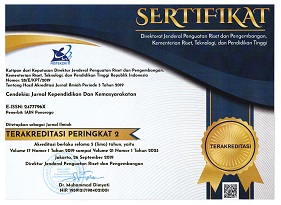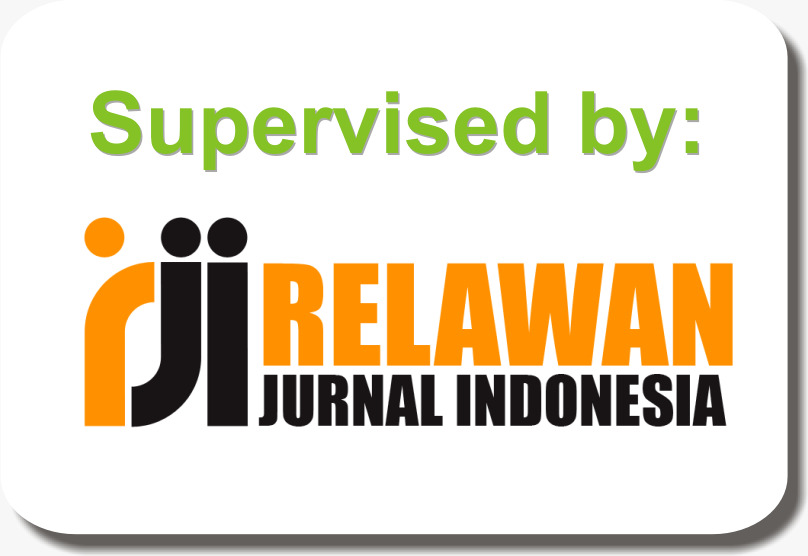Logic Model Evaluation to Work Oriented Education Program Through Joint Madrasah Community
DOI:
https://doi.org/10.21154/cendekia.v16i2.1373Keywords:
Logic Model, Work-Oriented Education Program, Joint Madrasah CommunityAbstract
Program penguatan ekonomi kreatif pada siswa madrasah melalui Work-oriented education program di Pariaman dilakukan melalui pembentukan Joint Madrasah Community yang digagas oleh STIT Syekh Burhanuddin Pariaman. Program ini memberikan pendampingan pelatihan industri ekonomi kreatif yaitu pelatihan public speaking dan kaligrafi berbasis digital printing. Tujuan program adalah menyiapkan lulusan madrasah siap kerja dan sekaligus mengurangi pengangguran lulusan madrasah yang selama ini penyumbang terbesar di Sumatera Barat. Metode penelitian ini adalah penelitian evaluasi logic model menggunakan pendekatan mixed method yaitu pendekatan campuran kualitatif dan kuantitatif. Pendekatan program menggunakan Comunity Based Research design. Analisa data kualitatif meliputi pengumpulan data, display data, verifikasi data dan penarikan kesimpulan Analisa data kuantitatif adalah uji independent t-test menggunakan program SPSS. Hasil program Work Oriented Education Program through Joint Madrasah Community terbukti berpengaruh signifikan terhadap penguatan life skill siswa madrasah dengan nilai a=0.000 < 0.05. Keberhasilan program 64.71% lulusan Madrasah diserap kerja jurnalistik dan broadcasting dan 70 persen di sektor kerja digital printing art kaligrafi. Rekomendasi program perlu dilanjutkan dengan memperluas jaringan komunitas madrasah negeri dan swasta yang ada di Pariaman.
تم تنÙيذ برنامج تعزيز الاقتصاد الإبداعي ÙÙŠ طلاب المدارس من خلال برنامج تعليمي موجه للعمل ÙÙŠ باريامان من خلال إنشاء مجتمع المدارس المشتركة الذي بدأه STIT الشيخ برهان الدين باريامان. يوÙر هذا البرنامج المساعدة التدريبية ÙÙŠ صناعة الاقتصاد الإبداعي ØŒ وبالتØديد التدريب على التØدث العام والخط الرقمي. الهد٠من البرنامج هو إعداد خريجي المدارس الجاهزة للعمل ÙˆÙÙŠ Ù†Ùس الوقت تقليل البطالة لخريجي المدارس الدينية الذين كانوا أكبر المساهمين ÙÙŠ غرب سومطرة. هذه الطريقة البØثية هي بØØ« تقييم نموذج منطقي باستخدام نهج طريقة مختلطة ØŒ وهي مزيج من النهج النوعية والكمية. يستخدم نهج البرنامج تصميم البØØ« القائم على المجتمع. يشتمل تØليل البيانات النوعية على جمع البيانات وعرض البيانات والتØقق من البيانات والاستنتاجات ØŒ وتØليل البيانات الكمية هو اختبار t مستقل باستخدام برنامج SPSS. أثبتت نتائج برنامج التعليم الموجه Ù†ØÙˆ العمل من خلال المجتمع المدرسي المشترك aتأثيرًا كبيرًا على تعزيز المهارات الØياتية لطلاب المدرسة الدينية بقيمة = 0.000 <0.05. Ù†Ø¬Ø§Ø Ø§Ù„Ø¨Ø±Ù†Ø§Ù…Ø¬ هو 64.71Ùª من خريجي المدارس الثانوية الذين يستوعبهم العمل الصØÙÙŠ والبث الإذاعي Ùˆ 70Ùª ÙÙŠ قطاع ÙÙ† الطباعة الرقمية. يجب أن تستمر توصيات البرنامج من خلال توسيع شبكة مجتمعات المدارس العامة والخاصة ÙÙŠ باريامان.
Downloads
Published
Issue
Section
License
Copyright & License
Please find the rights and licenses in Cendekia: Jurnal Kependidikan dan Kemasyarakatan. By submitting the article/manuscript, the author(s) agree with this policy. No specific document sign-off is required.
1. License
The non-commercial use of the article will be governed by the Creative Commons Attribution license as currently displayed on the Creative Commons Attribution-NonCommercial 4.0 International License.
2. Author(s)' Warranties
The author warrants that the article is original, written by the stated author(s), has not been published before, contains no unlawful statements, does not infringe the rights of others, is subject to copyright that is vested exclusively in the author and free of any third party rights, and that any necessary written permissions to quote from other sources have been obtained by the author(s).
3. User/Public Rights
The spirit of Cendekia: Jurnal Kependidikan dan Kemasyarakatan is to disseminate articles published as free as possible. Under the Creative Commons license, Cendekia: Jurnal Kependidikan dan Kemasyarakatan permits users to copy, distribute, display, and perform the work for non-commercial purposes. Users will also need to attribute authors and Cendekia: Jurnal Kependidikan dan Kemasyarakatan on distributing works in the journal and other media of publications. Unless otherwise stated, the authors are public entities as soon as their articles got published.
4. Rights of Authors
Authors retain all their rights to the published works, such as (but not limited to) the following rights;
- Copyright and other proprietary rights relating to the article, such as patent rights,
- The right to use the substance of the article in own future works, including lectures and books,
- The right to reproduce the article for own purposes,
- The right to self-archive the article,
- The right to enter into separate, additional contractual arrangements for the non-exclusive distribution of the article's published version (e.g., post it to an institutional repository or publish it in a book), with an acknowledgment of its initial publication in this journal (Cendekia: Jurnal Kependidikan dan Kemasyarakatan).
5. Co-Authorship
If the article was jointly prepared by more than one author, any author submitting the manuscript warrants that he/she has been authorized by all co-authors to be agreed on this copyright and license notice (agreement) on their behalf and agrees to inform his/her co-authors of the terms of this policy. Cendekia: Jurnal Kependidikan dan Kemasyarakatan will not be held liable for anything arising due to the author(s) internal dispute. Cendekia: Jurnal Kependidikan dan Kemasyarakatan will only communicate with the corresponding author.
6. Royalties
Being an open accessed journal and disseminating articles for free under the Creative Commons license term mentioned, the author(s) are aware that Cendekia: Jurnal Kependidikan dan Kemasyarakatan entitles the author(s) to no royalties or other fees.
7. Miscellaneous
Cendekia: Jurnal Kependidikan dan Kemasyarakatan will publish the article (or have it published) in the journal if the article's editorial process is completed. The editors of Cendekia: Jurnal Kependidikan dan Kemasyarakatan may modify the paper to a style of punctuation, spelling, capitalization, referencing, and usage that deems appropriate. The author acknowledges that the article may be published so that it will be publicly accessible, and such access will be free of charge for the readers, as mentioned in point 3.

















